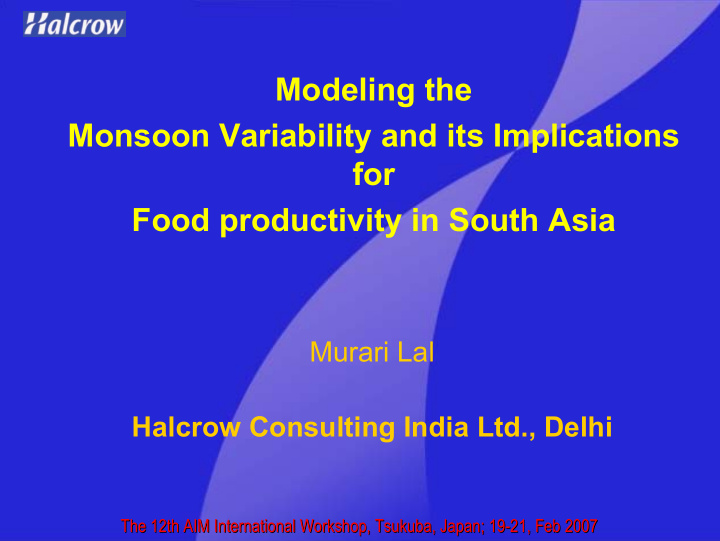



Modeling the Monsoon Variability and its Implications for Food productivity in South Asia Murari Lal Halcrow Consulting India Ltd., Delhi The 12th AIM International Workshop, Tsukuba, Japan; , Tsukuba, Japan; 19 19- -21, Feb 2007 21, Feb 2007 The 12th AIM International Workshop
Agriculture in South Asia – – Agriculture in South Asia Strengths & Challenges Strengths & Challenges Strong strides made in increasing the production in the past 50 Strong strides made in increasing the production in the past 50 years mainly due to adoption of HYVs and other technological years mainly due to adoption of HYVs and other technological developments in India and elsewhere, developments in India and elsewhere, Subsistence agriculture with small land holdings Subsistence agriculture with small land holdings and skewed distribution of land, and skewed distribution of land, Wide variation in regional productivities, Wide variation in regional productivities, Majority still depend on rainfed agriculture, Majority still depend on rainfed agriculture, Frequently affected by extreme weather events such as heat Frequently affected by extreme weather events such as heat waves, droughts, floods and cyclones, waves, droughts, floods and cyclones, Significant proportion of population still reels under poverty, Significant proportion of population still reels under poverty, malnutrition and chronic hunger, and malnutrition and chronic hunger, and Emerging challenges – – Climate change, WTO, economic Climate change, WTO, economic Emerging challenges liberalization etc. liberalization etc.
Per capita availability of food grains in India has increased in the 1990s: up by 12 grams a day from 472 grams per day in 1990 to 485 grams per day in 2000. But the deceleration in food grains production in the 1990s creates the spectre of food shortage in the years ahead. The fortunes of the agricultural sector in South Asia are heavily dependent on monsoon making it highly vulnerable to mercies of weather. The agricultural sector contributes 25% to the economy and 65% to the employment in India; this sector is crucial to the economy of most other countries in the region as well.
Observed Rainfall Variability in India
Observed changes in rainfall over south Asia
India’s groundwater juggernaut is accelerating !!
Key Vulnerabilities
Observed Climate Change over South Asia
Climate Variability and Climate Change over South Asia
Projected Seasonal Changes in Projected Seasonal Changes in Surface Air Temperature, Rainfall, Surface Air Temperature, Rainfall, Surface Runoff and Soil Moisture over South Asia Surface Runoff and Soil Moisture over South Asia
Simulated effects of de-glaciation on Himalayan river flows over a century
Climate Variability & Rice Harvest in India
CO 2 Fertilization – Crop Productivity
Why Global Food Security? Number of People at Risk of Hunger 900 80 Poeple at Risk of Hunger (millions) 800 % undernourished 60 700 600 A2 40 500 B2 B1 400 A1 20 300 200 0 100 80 100 120 140 160 180 200 0 Index of Food Supply / Food Required 2000 2010 2020 2030 2040 2050 2060 2070 2080
Food Security in South Asia - Climate Variability and Climate Change Climate variability will continue to affect Frequency distribution of daily maximum temperatures strategic grain supplies and food security of many nations in South Asia. The rising surface air temperatures and carbon dioxide and enhanced variability in rainfall associated with global warming could have serious direct and indirect consequences on crop production and hence food security. In the 21 st century, South Asian countries have to produce more food and other agricultural commodities under conditions of diminishing per capita arable land and irrigation water resources and expanding biotic as well as abiotic stresses including the climatic constraints.
Observed response of wheat to climate variability in South Asia
Changes in wheat-production potential versus increase in atmospheric CO2 concentrations and related global warming in South Asia Current cultivated land 110 HAD3 100 Index (1961-90 = 100) CSIRO 90 CGCM2 NCAR 80 HAD3 NCAR 70 All cultivable land CGCM2 60 CSIRO 110 50 300 400 500 600 700 800 900 HAD3 100 Index (1961-90 = 100) CO 2 ppm CSIRO 90 CGCM2 NCAR 80 HAD3 CGCM2 70 NCAR 60 CSIRO 50 300 400 500 600 700 800 900 CO 2 ppm
Changes in cereal-production potential versus increase in atmospheric CO2 concentrations and related global warming in South Asia Current cultivated land 115 HAD3 Index (1961-90 = 100) CSIRO 110 CGCM2 NCAR All cultivable land 105 HAD3 NCAR 115 100 CGCM2 HAD3 CSIRO Index (1961-90 = 100) CSIRO 110 95 CGCM2 300 400 500 600 700 800 900 NCAR 105 HAD3 CO 2 ppm CGCM2 100 NCAR CSIRO 95 300 400 500 600 700 800 900 CO 2 ppm
Adaptation Practices in Agriculture
Spatial and temporal scales in crop simulation modeling
An Integrated Approach to Impact Assessment
Future Water Availability in South Asia: Issues to be addressed � How much more water (agriculture, industry and domestic needs) would be required at various temporal and spatial scales and which basins have the potential to contribute to this demand? � How can the productivity of water use be increased? � What can be done to capture / tap the unutilized return flows? � What is the potential for water transfers in and out of major river basins? � What would be the potential contribution from groundwater for meeting future water demand?
Development and Management of Water Resources including Institutional Capacity Building
Drought Management
Prevention & Management of Droughts
Adaptation to Floods
Mainstreaming the climate change into framing policy options for water resource management
Sustainable Production - Methodology
Managing Climate Variability and Climate Change
Recommend
More recommend